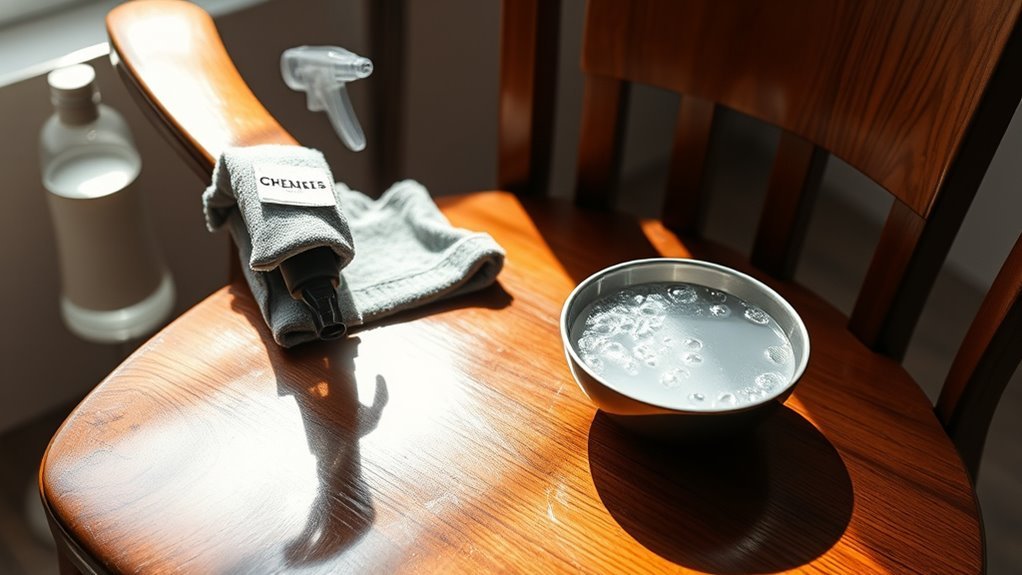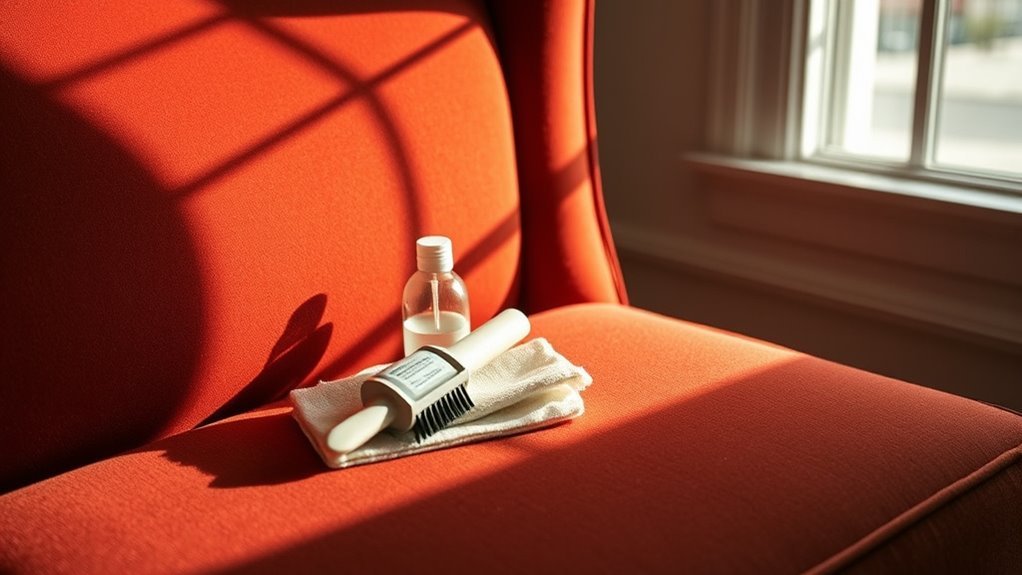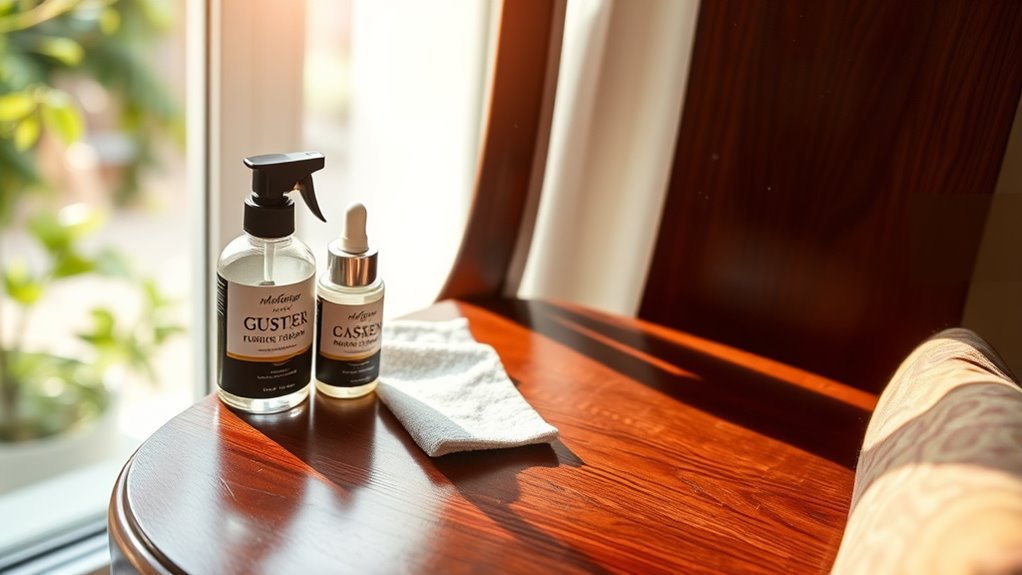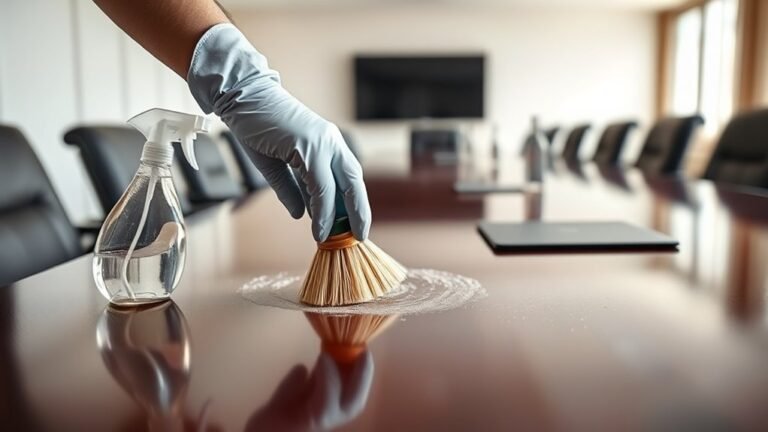Daily Maintenance Tips for Chair
You should clean your chair daily by wiping surfaces with a microfiber cloth and vacuuming fabric to remove dust and oils. Check screws regularly and tighten any that feel loose to maintain stability. Protect upholstery by spot treating stains immediately and using fabric protector sprays. Lubricate moving parts sparingly with appropriate grease to prevent wear. Store chairs away from sunlight and moisture. Keep these habits consistent, and you’ll guarantee comfort and extend your chair’s lifespan—explore further for detailed care techniques.
Regular Cleaning Techniques

When maintaining your chair, regular cleaning is essential to preserve its appearance and functionality. You should establish a cleaning frequency based on usage: light use calls for weekly dusting, while heavy use requires bi-weekly or even daily attention. Select cleaning supplies appropriate for your chair’s material—microfiber cloths and mild detergent for fabric, or specialized leather cleaner for leather surfaces. Avoid harsh chemicals that could degrade finishes or fabrics. For thorough cleaning, vacuum crevices and wipe all surfaces to remove dirt and oils that accumulate over time. Consistent cleaning prevents buildup that impairs the chair’s performance and lifespan. By adhering to a precise cleaning routine with the right supplies, you maintain your chair’s freedom of movement and aesthetic, ensuring it remains reliable and comfortable day after day.
Checking and Tightening Screws
You should start by carefully inspecting your chair to identify any loose screws that could affect its stability. Use the correct screwdriver type and size to avoid damaging the screw heads while tightening them securely. Make it a habit to schedule regular inspections to maintain the chair’s structural integrity over time.
Identifying Loose Screws
Anyone maintaining a chair should regularly inspect all screws for looseness, as even slight movement can compromise stability and safety. To effectively identify loose screws, you need to recognize various screw types and apply proper identification methods. Start by visually checking each screw head for gaps or misalignment. Next, gently wiggle each screw to feel for unwanted movement.
| Screw Type | Identification Method |
|---|---|
| Phillips | Check for stripped or loose fit |
| Flathead | Look for rocking or gaps |
| Allen (Hex) | Test tightness with manual feel |
| Torx | Examine for wobbling or play |
Proper Screwdriver Usage
Proper screwdriver usage is essential for checking and tightening screws effectively, guaranteeing your chair remains secure and stable. Begin by selecting the correct screwdriver type—Phillips, flathead, or Torx—matching the screw head precisely to avoid stripping. When tightening, apply steady, controlled pressure, turning clockwise until snug; avoid over-tightening, which can damage threads or weaken joints. Regular tool maintenance is key: keep your screwdriver tips clean and sharp for peak grip and efficiency. Inspect handles for cracks or wear to maintain control and safety during use. Using the right screwdriver type and maintaining your tools guarantees you can confidently secure your chair’s screws, preserving its integrity and your freedom of movement without unnecessary hassle or risk.
Scheduling Regular Inspections
Although it might seem tedious, scheduling regular inspections to check and tighten screws is essential for maintaining your chair’s safety and functionality. Establish an inspection frequency based on usage intensity and environment. Use a maintenance checklist to guarantee no screw is overlooked, preventing loosening that compromises stability. Here’s a recommended schedule:
| Inspection Frequency | Task |
|---|---|
| Weekly | Visual screw check |
| Monthly | Tighten all screws |
| Quarterly | Full maintenance audit |
Protecting Fabric and Upholstery
You should establish a regular vacuuming routine to remove dust and debris from your chair’s fabric. When spills occur, apply spot cleaning techniques promptly to prevent stains from setting. Additionally, consider using fabric protection sprays to create a barrier against future dirt and moisture.
Regular Vacuuming Routine
Vacuuming your chair at least once a week helps prevent dust, dirt, and allergens from embedding deep into the fabric and upholstery. By adopting effective vacuuming techniques, you maintain the chair’s appearance and extend its lifespan without restricting your freedom to enjoy it. Focus on these key points for ideal upholstery care:
- Use a brush attachment to gently agitate and lift dirt from fabric fibers.
- Adjust suction power to avoid damaging delicate materials.
- Vacuum all surfaces, including seams and crevices where debris accumulates.
- Perform slow, overlapping strokes to guarantee thorough cleaning.
- Empty the vacuum bag or canister regularly to maintain suction efficiency.
Following this routine keeps your chair fresh and comfortable, giving you the freedom to relax without worrying about hidden allergens or premature wear.
Spot Cleaning Techniques
Since spills and stains can occur unexpectedly, mastering spot cleaning techniques is essential to protect your chair’s fabric and upholstery from permanent damage. Start by identifying the fabric type to select an appropriate cleaning solution—test it on a hidden area first. For stain removal, gently blot the spill with a clean cloth; avoid rubbing, which can embed stains deeper. Use a mild detergent-based cleaning solution or specialized upholstery cleaner, applying it sparingly. After treatment, blot excess moisture with a dry cloth and allow the area to air dry completely. Repeat the process if necessary, but avoid oversaturating the fabric to prevent damage. By responding promptly and using targeted cleaning solutions, you’ll maintain your chair’s appearance and extend its lifespan without compromising your freedom to enjoy it daily.
Fabric Protection Sprays
Brushing on fabric protection sprays can markedly reduce the risk of stains and spills penetrating your chair’s upholstery. Selecting the right fabric spray types—such as silicone-based or fluoropolymer formulas—ensures ideal defense tailored to your chair’s material. Mastering proper application techniques is essential: always test sprays on an inconspicuous area first, apply evenly from 6-8 inches away, and allow adequate drying time. These sprays create an invisible barrier, repelling liquids and dirt while preserving breathability and texture. To maximize effectiveness:
- Choose a spray compatible with your fabric type
- Use a clean brush or spray nozzle for uniform coverage
- Avoid oversaturation to prevent fabric stiffness
- Reapply protection every 3-6 months depending on use
- Store sprays away from heat and direct sunlight
This precision keeps your chair fresh and stain-resistant.
Lubricating Moving Parts
A well-lubricated chair guarantees smooth operation and extends the lifespan of its moving components. To keep your chair functioning freely, select the appropriate grease types—synthetic or lithium-based greases are ideal for metal joints, while silicone-based lubricants suit plastic parts. Avoid heavy oils that attract dust. Apply lubrication sparingly using precise application methods: a small brush or a syringe guarantees targeted coverage without excess. Focus on pivot points, casters, and adjustment mechanisms. Before application, clean the parts thoroughly to remove old grease and debris, promoting ideal adhesion. Regular lubrication prevents wear, reduces noise, and maintains ease of movement, giving you the freedom to adjust and maneuver without resistance. Incorporate this routine into your maintenance schedule for lasting comfort and performance.
Preventing and Treating Stains

Although spills and stains can happen unexpectedly, you can greatly reduce their impact by acting quickly and using the right cleaning agents for your chair’s material. Different fabric types require tailored stain removal methods, so identify your chair’s fabric before treating any marks.
Here’s how you can effectively prevent and treat stains:
- Blot spills immediately with a clean, absorbent cloth to avoid spreading.
- Use mild detergents for delicate fabrics like silk or velvet.
- Avoid harsh chemicals on synthetic materials to prevent damage.
- Test stain removers on a hidden area to verify colorfastness.
- Regularly vacuum fabric chairs to remove dust and prevent dirt embedding.
Proper Storage and Placement
When you’re not using your chair, proper storage and placement are essential to maintaining its condition and longevity. Ideal chair placement avoids direct sunlight, which can cause fading and material degradation. Confirm the chair rests on a level surface to prevent structural stress or imbalance. Utilize storage solutions that protect against dust, moisture, and temperature fluctuations—such as breathable covers or climate-controlled spaces. Avoid stacking chairs unless designed for it, as excessive weight may deform frames or cushions. If storing for extended periods, detach removable parts and clean thoroughly beforehand. Prioritize accessibility in your storage setup to facilitate regular maintenance without hassle. By applying these precise storage strategies, you’ll extend your chair’s lifespan and maintain its functionality, giving you the freedom to use it whenever you wish.
Frequently Asked Questions
How Do I Repair a Broken Chair Leg?
Ever wondered how to fix a broken chair leg without hassle? First, assess the damage and gather repair techniques like wood glue, clamps, and screws. Remove any loose fragments, apply glue to the broken surfaces, then clamp firmly to dry. For extra strength, reinforce with screws once dried. You’ll regain your chair’s stability and freedom to move around confidently, all by mastering these precise steps.
Can I Refinish Wooden Chair Surfaces Myself?
Yes, you can refinish wooden chair surfaces yourself by mastering key refinishing techniques. Start with thorough surface preparation—clean, sand, and remove old finish to guarantee adhesion. Choose the right stain or paint and apply evenly. Finish with a protective clear coat for durability. With patience and attention to detail, you’ll restore your chair’s look and enjoy the freedom of DIY craftsmanship without needing professional help.
What Is the Best Way to Remove Chair Odors?
Ever wonder how to banish chair odors like a pro? You’ll want to start with odor absorbing products such as activated charcoal bags or baking soda sprinkled gently on fabric. Let them sit to draw out smells, then vacuum. For quick refreshers, fabric fresheners designed specifically for upholstery can neutralize odors without overpowering scents. Combining these methods keeps your chair smelling clean, giving you the freedom to enjoy fresh comfort every day.
How Often Should I Replace Chair Casters?
You should replace chair casters when you notice wear or damage affecting chair stability, typically every 1-3 years depending on usage. Different caster materials—like nylon, polyurethane, or rubber—affect durability and floor compatibility. Inspect them regularly for cracks or uneven rolling. Choosing the right caster materials guarantees smooth movement and safety, giving you freedom to move effortlessly without risking falls or uneven seating. Don’t wait until stability’s compromised; proactive replacement’s key.
Are There Eco-Friendly Cleaning Products for Chairs?
Ever wondered if your cleaning routine could save the planet? You’re in luck—there are plenty of eco-friendly alternatives designed specifically for chairs. Natural cleaners like vinegar, baking soda, and lemon juice work wonders without harsh chemicals. They’re effective, safe, and align with your desire for freedom from toxins. By choosing these options, you not only maintain your chair’s condition but also reduce your environmental footprint effortlessly.






